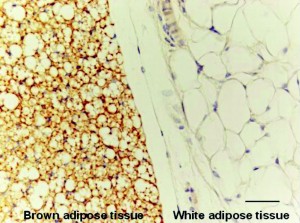 A new signaling pathway has been identified that stimulates the glucose uptake in brown fat cells that might be helpful in treating type 2 diabetes and obesity. The study was published in The Journal of Cell Biology.
A new signaling pathway has been identified that stimulates the glucose uptake in brown fat cells that might be helpful in treating type 2 diabetes and obesity. The study was published in The Journal of Cell Biology.
The study, lead by Jessica M. Olsen from the Department of Molecular Biosciences, The Wenner-Gren Institute, Stockholm University in Sweden, represents a promising approach to solving the insulin uptake problem in diabetic patients, and may be effective as a weight loss therapy.
The scientific background is as simple as this: when the body needs to face cold temperatures, the sympathetic nervous system, responsible for the regulation of involuntary actions of the body, activates the adrenoceptors existent on the surface of brown fat cells in order to initiate a process of glucose uptake from the bloodstream. This uptake in brown fat cells will serve as a fuel supply so these cells produce body heat and react to the initial cold temperature problem.
The glucose uptake can also be induced by insulin, and this uptake process is well understood. The mechanisms involved in the uptake process that depend on the adrenoceptors, on the other hand, have remained a mystery.
Through experiments in mice, the Swedish researchers found that the mTORC2 signaling pathway is the key of the whole regulatation of the adrenoreceptor-stimulated glucose uptake process in brown fat cells. The pathway requires a protein kinase, the mTOR, whose role it is to stimulate the transport to the brown cells’ surface of a glucose-importing protein, called GLUT1.
“One of the most interesting characteristics of this newly discovered signal pathway is that it differs from the signal pathway triggered by insulin,” commented Tore Bengtsson from the Department of Molecular Biosciences, Wenner-Gren Institute, Stockholm University and senior author of the study. “This means that the signal pathway in brown fat can most likely be activated even in patients with type 2 diabetes, where insulin signaling is impaired.”
Thanks to its characteristics, the mTORC2 pathway might solve the blood sugar level problem in patients with type 2 diabetes, and through brown fat cells’ energy-burning power, it might work as an effective weight loss therapy as well.

